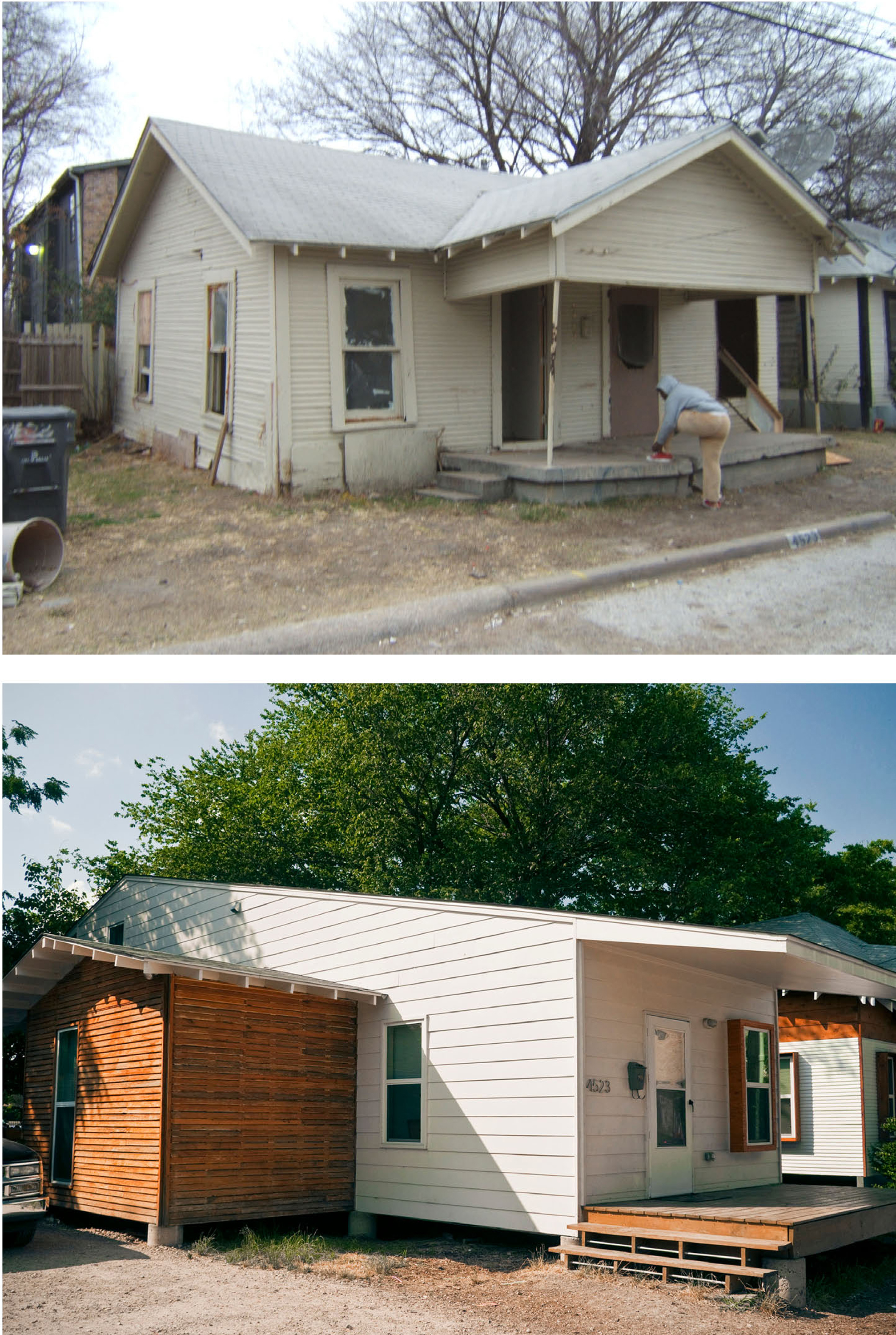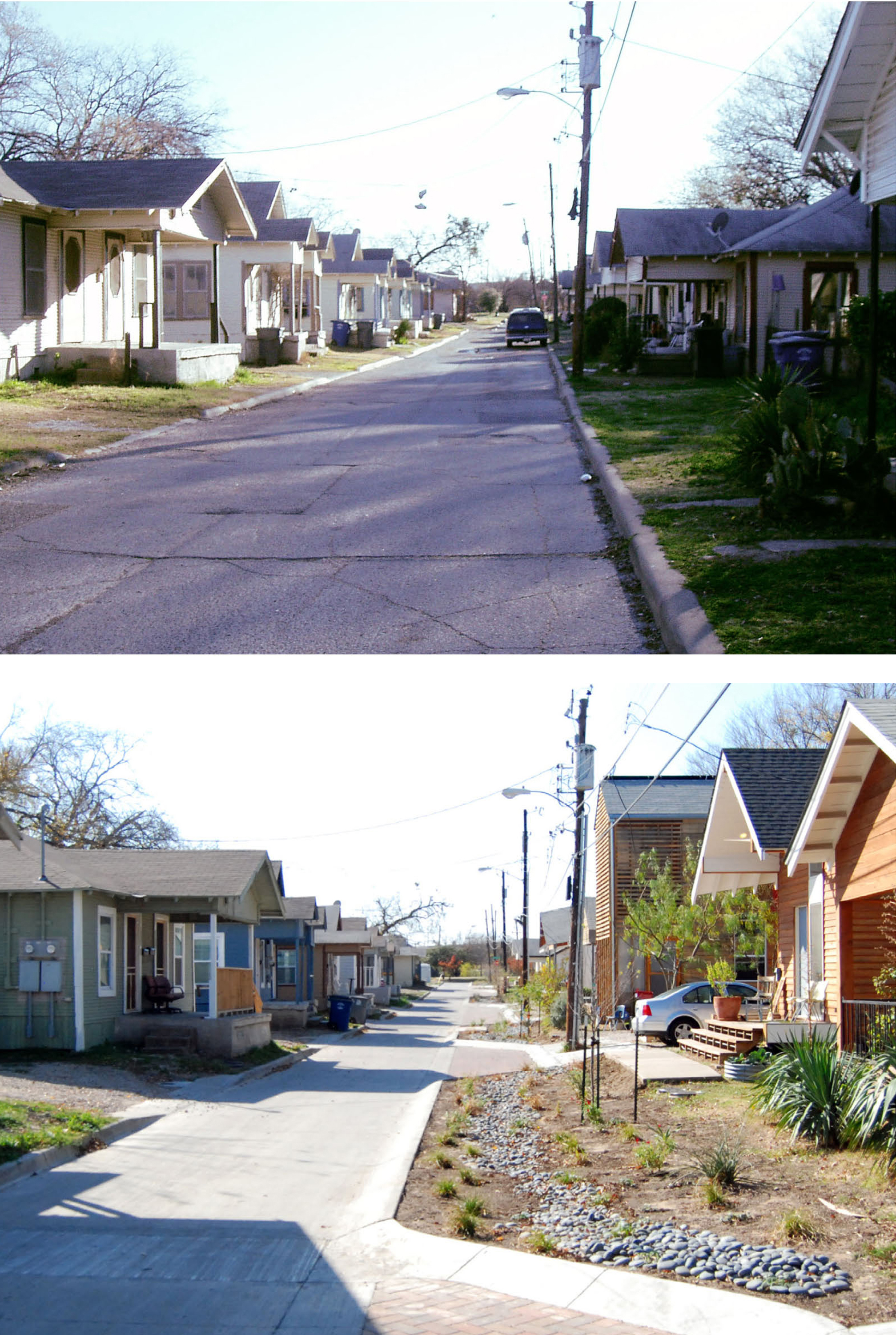Learn more about Neighborhood Stories and POP Dallas.
Wynnewood North Stories
Learn more about Neighborhood Stories and POP Dallas.
As part of the bcWORKSHOP’s POP [People Organizing Place] Dallas initiative, Dallas Neighborhood Stories will produce a series of events that engage Dallas’s diverse communities in an active dialogue about the history and future of the city.
On the afternoon of Saturday, May 11th, the third exhibit in the Neighborhood Stories series was held in Wynnewood North, a neighborhood in Oak Cliff. Conceived, constructed, and marketed as part of Angus Wynne, Jr.’s groundbreaking high-design, midcentury development, Wynnewood North combines single-family homes, apartments, and a retail core to function as a “city within a city” that has maintained its character over the years and is making strides towards re-imagining itself for the future.
The history and evolution of the neighborhood were displayed in a gallery exhibit that included a “mock up” living room featuring midcentury modern furniture on loan from Collage 20th Century Furniture. Event visitors stopped by for movie snacks before heading into a screening of a short film featuring interviews with local residents Janice Coffee, Joseph Hernandez, Anita Johnson, Steve Johnson, Silver Poteete, Ruby Sam, and Reverend Johnny Flowers. Attendees had the opportunity to contribute their own personal stories and memories about the neighborhood as well as play “So You Want to Build...Wynnewood Village”, an interactive game that generated ideas for the future development of Wynnewood Village Shopping Center.
The next event will be held in the Tenth Street Historic District - please contact us if you'd like to get involved!
Dallas Public Agenda
Learn more about POP Dallas.
As part of our POP [People Organizing Place] initiative, bcWORKSHOP announces the launch of The Public Agenda, a digital tool that maps the voting agenda of the Dallas City Council by neighborhoods.
Under a council-manager form of government, the City Council is responsible for the legislative function of the city, including establishing policy, passing local ordinances, voting appropriations, and developing an overall vision. In Dallas, the Council convenes on the second and fourth Wednesday of each month to consider action on the voting agenda.
The Public Agenda uses the POP City Map as a framework for understanding the geography of the decisions that come before the Council. By reformatting the published Council agenda, bcWORKSHOP hopes to enhance opportunities for citizen engagement. Healthy and vibrant neighborhoods are the foundation of a successful city, and every citizen should be empowered as a neighborhood and city advocate.
In announcing the launch of an Open Data Portal this fall, the City of Dallas has issued a Press Release that includes The Public Agenda as an example of products that can be created with open access to data.
David Perkes at Shopfront
Learn more about bcSHOPFRONT.
Public Interest Practices in Architecture
David Perkes is part of a four person national team with Bryan Bell, Roberta Feldman, and Sergio Palleroni to receive the 2011 Latrobe Prize from the American Institute of Architects, a biennial prize dedicated to broadening the perspective and scope of architecture to include cross-disciplinary fields and expertise. Their project is entitled, "Public Interest Practices in Architecture" and seeks to address three questions.
- What are the needs that can be addressed by public interest practices?
- How are current public interest practices operating?
- What is necessary for public interest work to become a significant segment of architecture practice?
The Latrobe Prize is awarded by the American Institute of Architects College of Fellows. Founded in 1952, this organization is composed of members of the Institute who are elected to Fellowship by a jury of their peers. The College of Fellows seeks to stimulate a sharing of interests among Fellows, promote the purposes of the Institute, advance the profession of architecture, mentor young architects, and be of ever-increasing service to society. Toward that end, the College seeks to encourage research that broadens the perspective and scope of architecture to include cross-disciplinary fields and expertise through its biennial competition: the Latrobe Prize.
David Perkes is a licensed architect and professor for Mississippi State University. He is the founding director of the Gulf Coast Community Design Studio, a professional outreach program of the College of Architecture, Art + Design, Mississippi State University. The design studio was established in Biloxi, Mississippi following Hurricane Katrina and is providing planning, landscape and architectural design support to many Gulf Coast communities and non-profit organizations. The design studio has assisted in the renovation of hundreds of damaged homes and over two hundred new house projects in Biloxi and other communities. The Biloxi house projects were awarded an Honor Citation from the Gulf States Region AIA in 2007, a Terner Award for Innovative Housing and a Mississippi AIA Honor Citation in 2009. The Bayou Auguste restoration project received a Mississippi AIA Honor Citation in 2012. In 2011 David was selected by the White House as a “Champion of Change” for his work on the Gulf Coast.
Before creating the Gulf Coast Community Design Studio, David was the director of the Jackson Community Design Center and taught in the School of Architecture’s fifth year program in Jackson, Mississippi. Under his leadership the Jackson Community Design Center assisted many community organizations and received numerous national and local awards, including a Mississippi AIA Honor Award for the Boys and Girls Club Camp Pavilion. David has a Master of Environmental Design degree from Yale School of Architecture, a Master of Architecture degree from the University of Utah, and a Bachelor of Science degree in Civil and Environmental Engineering from Utah State University. In 2004 David was awarded a Loeb Fellowship from the Harvard Graduate School of Design.
Belden Trail Groundbreaking
Learn more about our work in the RGV.
March 21st, 2013 marked the groundbreaking ceremony for Belden Trail in Brownsville, TX. The ceremony was held at the intersection of West 8th and Fronton Street behind Skinner Elementary School. About 100 people were in attendance, including Brownsville Mayor Martinez, Commissioner Virrareal, Skinner Elementary Principal Moore, Assistant Superintendent Haynes, Community Development Corporation Brownsville Executive Director Nick Mitchell-Bennett, and Commissioner Rose Gowen who spoke on the importance of the Trail. See local coverage of the event from the Brownsville Herald and United Brownsville!
The groundbreaking was a celebration of every contribution by community residents, stakeholders, and project partners toward the development, planning, and design of this project. The process was a community wide effort of collaboration between adjacent residents and institutions as well as project partners and the City of Brownsville.
The trail design includes a pedestrian and bike pathway connecting Skinner Elementary School to Praxedis Orive Jr. Park on Palm Boulevard. The 10 foot-wide pathway also runs alongside Sams Memorial Stadium. The trail design includes:
- local plants and shade trees including tall grasses and wildflowers, live oak trees, red yucca, sacahuista, and mealy blue sage
- bike racks, play areas, and local art at Rotary Park, Skinner Elementary School, and the Elizabeth Street intersection.
- safe street crossings with the addition of street chokers to slow traffic, signage, and crosswalks.
The addition of this public space in Brownsville will encourage healthy lifestyles, diversify transportation options and increase access to natural resources. The trail will serve as an example for continued development of a city-wide trail system increasing city residents' access to cultural, recreational, and natural amenities.
The trail will be under construction for the next two months. You can read more about the background of Belden Trial here. Be sure to like The Friends of Belden Trail on Facebook for updates!
Activity Book Launch
Learn more about POP Dallas.
The POP [People Organizing Place] Dallas Toolkit is an ongoing initiative that provides citizens with a common language and set of tools to gather neighborhoods around creating a vision & organizing community change. bcWORKSHOP is excited to announce the POP Toolkit Activity Book coming soon to a neighborhood near you! To participate in the pilot, you will need to gather an inclusive group of neighborhood stakeholders that will commit to seeking positive change guided by four meetings with bcWORKSHOP.
During the first meeting, bcWORKSHOP will help you collectively map and prioritize the issues and assets that sustain your neighborhood. This is used in the second meeting to generate a prioritized list of goals, which you will discover more about by building a Workshop around a Tool. The third meeting with bcWORKSHOP moves from reflection on discoveries to identifying partners and an audience to help reach your goal. You will build a second workshop around another Tool to share your goal with this audience. The last meeting with bcWORKSHOP helps identify and plan how a change will be made once the issue is understood and partners are gathered.
The Toolkit is a resource for neighborhoods in Dallas (and potentially beyond)! It teaches design thinking in the form of Tools that engage creative problem solving and Metrics that identify and compare outcomes. If your neighborhood is interested in exploring your assets and issues through the Toolkit, please be in touch!
Affordable Housing Choices
Learn more about sustainABLEhouse and our work in the RGV.
Working in partnership with the Community Development Corporation of Brownsville (CDCB), bcWORKSHOP is able to implement the sustainABLEhouse process at scale in Cameron County, Texas. CDCB is the largest non-profit producers of single-family affordable housing for homeownership in the State of Texas. Their Colonia Redevelopment program replaces homes in colonias that are substandard due to poor construction and/or natural disasters. The CDCB/ bcWORKSHOP partnership was formed to provide greater choice to clients in need of new housing while offering more environmentally friendly practices and enhancing the design of local affordable housing. Each client is an integral part of the design process helping guide design decisions ranging from basic layout to landscape and finishes. Families participating in this program now have the choice to select from a new home design catalogue or collaborate on custom, site-specific designs meeting their needs.
The design catalogue is an ever evolving set of designs influenced by previous client engagement. bcWORKSHOP provides family engagement, designs and construction administration services while CDCB provides client enrollment, financial, and construction management services. The home design catalogue is reviewed and updated as development continues, increasing the choices for sustainable and affordable housing typologies available in the area. The partnership is well on track to reach its goal to construct more than forty homes during 2013 through the sustainABLEhouse model.
Anticipated outcomes:
- Homeowners are empowered by the design process, investing more in their homes, and strengthening neighborhoods.
- Design and construction quality of affordable homes in the LRGV region will rise, and knowledge of sustainable practices will increase among local contractors.
- Homes tailored to each family will have higher functionality, resulting in lower long-term utility costs and environmental impact.
- A design catalogue is developed to supplement limited, outdated options for homebuilders. This catalogue will offer designs sensitive to both local context and culture, as a direct result of collaboration with colonia residents and families.
- Diversity of homes will maintain the existing vibrant communities, and strengthen colonia identity.
- Capacity of both CDCB and bcWORKSHOP will increase. CDCB’s programs will offer more design choice to its clients, and bcWORKSHOP will gain experience to scale the sustainABLEhouse initiative in the North Texas region.
3313 Beall Complete
Learn more about sustainABLEhouse.
The construction of the first sustainABLEhouse in Dallas is complete! The home is located at 3313 Beall Street, in the heart of the Dolphin Heights neighborhood. After a three and a half month build, the house is now for sale. Contact Helen Gonzales Crawford of Better Lifestyles Real Estate at (214)324-2497 if you are interested in purchasing the house.
Transforming Communities Through Art
Read more about our Shopfront series.
On March 19, 2013, bcSHOPFRONT hosted Rick Lowe of Project Row Houses. Rick Lowe is an artist who works and resides in Houston, Texas. His formal training is in the visual arts; over the past twenty years he has worked both inside and outside of art world institutions by participating in exhibitions and developing community-based art projects. Rick's work has been exhibited internationally including the Phoenix Art Museum; Museum of Contemporary Arts, Los Angeles; Neuberger Museum, Purchase, New York, Kwangji Biennale, Kwangji, Korea; and the Venice Architecture Biennale. His community building projects include Watts House Project, Los Angeles, CA; and a project for the Seattle Art Museum in their new Olympic Sculpture Park with David Adjaye. Rick has been honored with the Rudy Bruner Award in Urban Excellence Silver Medalist; the AIA Keystone Award; Loeb Fellow at Harvard University; Skandalaris Award for Excellence in Art Architecture; USA Booth Fellowship; and the Creative Time Annenberg Prize for Art and Social Change.
In commemoration of the Nasher Sculpture Center's 10th anniversary, Rick Lowe will participate in Nasher XChange, a dynamic art exhibition consisting of 10 newly - commissioned public sculptures by contemporary artists at sites throughout the city of Dallas from October 19, 2013 to February 16, 2014. Covering a diverse range of sites and approaches to sculpture, Nasher XChange represents the first citywide, museum-organized public art exhibition in the United States.
Project Row House (PRH) is a non-profit arts organization in Northern Third Ward, one of Houston’s oldest African-American communities. Lowe's belief that artwork can serve as a tool to both voice social issues and also create resolutions was the foundation of this project . This idea engaged the community, encouraging local residents to see value and opportunity in their neighborhood as the Project reinvented damaged, abandoned row houses in an isolated Houston neighborhood. Since inception, the PRH location has expanded from 22 properties to 40 over 6 blocks. The reinvented properties house artist residency programs, housing for young mothers in need, additional residences for low-income families, affordable office spaces, a community arts gallery, park, and other community centers. As PRH has grown, the impact on the community has multiplied- the neighborhood is more connected to the larger surrounding area, members of the neighborhood have organized to implement and establish their ideas, and a community development corporation was spawned, producing nine low income housing units to date.
Dolphin Heights Stories Film
Learn more about Neighborhood Stories and POP Dallas.
Dolphin Heights Stories
Learn more about Neighborhood Stories and POP Dallas.
As part of the bcWORKSHOP’s POP [People Organizing Place] Dallas initiative, Dallas Neighborhood Stories will produce a series of six events that engage Dallas’s diverse communities in an active dialogue about the history and future of the city.
See more photos on our Facebook page.
On the afternoon of Saturday, March 16th, the second exhibit in the Neighborhood Stories series was held in Dolphin Heights, a neighborhood in East Dallas. Home to one of the oldest inhabited sites in Dallas, Dolphin Heights has transformed over the past 170 years from a pioneer homestead to a resilient, though isolated, single-family neighborhood punctuated by a diverse set of land uses.
The history and evolution of the community was displayed in an exhibit and a short film featured interviews with current and former neighborhood residents Anna Hill, Ollie Lyons, George Collins, Carolyn Elliot, Walter Isler, and Laura Watson, as well as SMU professor of anthropology Dr. Caroline Brettell. Attendees had opportunities to contribute their own personal stories and memories about the neighborhood and enjoyed food from local restaurants and businesses including Luna's, Schepps Dairy, and RC Cola. In a nod to the circus that used stop in the neighborhood, kids played a selection of carnival games and faced off in an epic cornhole battle.
Upcoming events will be held in Wynnewood North, Tenth Street, and Mount Auburn - please contact us if you'd like to get involved!
Take Reading Public
Learn more about POP Dallas.
To support the Big Read Dallas, bcWORKSHOP was approached to create a graphic that maps the locations of spaces in Dallas good for reading. We took that one step further, and created an interactive web tool called Take Reading Public that shares public spaces friendly to reading in the city. By mapping the hundreds of parks, libraries, bookstores, and coffee shops in Dallas, we hope to reinforce a culture of reading by bringing it to the streets. This visual representation of local assets aims to bring positive activity to public spaces in Dallas and empower people through one of the best ways to build knowledge: reading. We also encourage users to share a message or photo about where they're reading with Twitter and Instagram, using #BigReadDallas.
The Big Read is a program of the National Endowment for the Arts, designed to restore reading to the center of American culture and encourage reading for pleasure and enlightenment. A partnership of D Magazine and Friends of the Dallas Public Library were awarded a grant to bring the Big Read to Dallas, and during the month of April the city will be engaged in reading one book together, Ray Bradbury's classic Fahrenheit 451 about a dystopian future in which books are banned. Over 20,000 copies are being distributed to Dallas ISD high school students this week.
Join us and thousands of other Dallas citizens by getting outside and reading!
Announcing bcSHOPFRONT
Public design is an international movement which emphasizes community planning and creates positive changes through the built environment. bcWORKSHOP employs design to deliver and advocate for more livable communities. Local experiences and interests direct our work. We form strong relationships through place based product development, and work daily ensuring design is accessible and in service to all communities no matter their economic resources.
bcSHOPFRONT is an initiative of bcWORKSHOP featuring exhibits, talks, and activities related to the national public design movement and its impact on Dallas. It examines work of all scales- local, regional, state, and national- which promotes public design as a commonplace process. To position Dallas within the larger movement, the inaugural Spring 2013 series relates WORKSHOP’s local work to influential national institutions and practitioners.
Dallas' Neighborhood Map
Learn more about POP Dallas.
Active and resilient neighborhoods are the foundation of a successful city. POP [People Organizing Place] Dallas is the bcWORKSHOP public design effort to strengthen the social, economic, and physical health of Dallas’s neighborhoods. The POP City Map is a new tool that frames how we naturally organize our communities: as neighborhoods. The City Map builds awareness of our city, celebrates the diverse places that give it character and texture, shares critical data on a local scale, and creates a platform for dialogue about its history and future. Filling a void among the city’s existing local resources, the map will serve as a valuable resource for residents, planners, developers, government and other organizations planning the future of our city. Strengthening the identities of Dallas’s neighborhoods, and lessening the reliance on directional references (e.g., North Dallas), enables Dallasites to reconnect more personally and purposefully with place.
Michael Sorrell Joins bcWORKSHOP Board
Michael J. Sorrell, 34th President of Paul Quinn College, was recently named to the buildingcommunityWORKSHOP Board of Directors. President Sorrell joins Stephanie Hunt, co-founder of the Hunt Institute for Engineering & Humanity at SMU, Betsy del Monte, FAIA, local sustainability proponent, John Greenan of Central Dallas CDC, and Brent Brown, AIA, Founding Director of the bcWORKSHOP.
Michael J. Sorrell is the 34th President of Paul Quinn College and the reigning “HBCU Male President of the Year”. Under his leadership, Paul Quinn is experiencing one of the greatest turnarounds in the history of higher education. Among the college’s numerous accomplishments during President Sorrell’s tenure are: winning the “2011 HBCU of the Year” and the “2012 HBCU Student Government Association of the Year” titles; the demolition of 15 abandoned campus buildings; partnering with PepsiCo to transform the football field into the two acre “WE over Me Farm”; and achieving full accreditation with the Transnational Association of Christian Colleges and Schools (TRACS).
Michael received his J.D. and M.A. in Public Policy from Duke University. While in law school, he was one of the founding members of the Journal of Gender Law & Policy and served as the Vice President of the Duke Bar Association. Michael was a recipient of the Sloan Foundation Graduate Fellowship, which funded his studies at both Harvard University’s Kennedy School of Government (as a graduate fellow) and Duke University. He graduated from Oberlin College with a B.A. in Government, served as Secretary-Treasurer of his senior class, was a two-time captain of the men’s varsity basketball team, and the school’s fifth all-time leading scorer.
Michael currently serves on the boards of Amegy Bank, Teach For America, the North Texas Public Broadcasting Company, Inc. and KIPP Truth Academy. He also has been recognized as one of the rising leaders in America by the Root Online Magazine through their “Root 100” and the Dallas Observer labeled him as one of Dallas’ “30 Most Interesting People”. Among his other recognitions are: the Excellence in Education Distinguished Alumni Award from St. Ignatius College Prep in Chicago, Illinois; the A. Kenneth Pye Award for Educational Excellence from Duke University’s School of Law; and the TRACS Leadership Award. He is a past recipient of the Dallas Urban League’s Torch for Community Leadership and both the President’s and C.B. Bunkley Awards from J.L. Turner Legal Association for his contributions to the Dallas legal community. President Sorrell is married to the former Natalie Jenkins and they have one son, two-year old Michael Augustus.
"We are very pleased that Michael has chosen to direct his considerable skills and leadership capacity towards advancing our mission of improving the livability and viability of communities," states WORKSHOP Director Brent Brown.
La Hacienda - Midway
Learn more about La Hacienda here.
The La Hacienda Casitas are quickly moving along with over half of the 56-units underway. Once the first eight homes were completed, work began on the remaining structures, consisting of eight different housing types, as well as on laundry facilities and other community buildings. Throughout this process care was taken to preserve existing trees across the site, providing need shade and a sense of age in the place. With construction scheduled to be complete in June 2013, the first five families have moved in, already filling this new community with life.
Congo Street Initiative
Learn more about our work in Dallas.
Congo Street is located just two miles from Dallas’s city center and three blocks from the Texas State Fair grounds in the East Dallas neighborhood of Jubilee Park, a 62-block area housing approximately 2,000 residents. With a density of 26 units per acre and houses averaging 600 square feet, Congo Street is a remnant of a socially and economically segregated time. Built around 1920, this small community of dwellings fell into disrepair with little attention from landlords, the surrounding neighborhood, or the City itself. Many current residents are the children and grandchildren of former renters and witness to multiple generations of its tight-knit community. The area continues to struggle with poverty, language barriers, low educational attainment, lack of job skills and vocational opportunities, and other challenges of lower-income communities.
The Congo Street Initiative started from the desire to help stabilize the home-ownership of five families on Congo Street, which was was forgotten and slated to be removed and redeveloped. The project grew through intense interaction with residents, stakeholders and partners into a collaborative design and redevelopment effort that produced three phases of work:
Holding House - With a common desire to remain on the street despite the urgent need to repair their homes, residents were hesitant to move forward with any plans that would displace them, even temporarily. The challenge was how to redevelop without relying upon relocation or incurring steep financial burden. bcWORKSHOP and the residents began by exploring alternative solutions. Through neighborhood meetings, the idea emerged to build a new residence on the street that would serve as a temporary home for each family during the evaluation and renovation/rebuilding of their homes. The Holding House model delivered a new value to this community by rebuilding it while retaining its social cohesion.
4537 - Holding House Completion - September 2008
De-constructing and re-constructing 5 family homes - Next, one by one, each family moved into the Holding House and was closely involved in the design and construction of the rebuilding of their homes. Instead of conventional demolition, each existing home was carefully deconstructed to preserve the materials. The incorporation of those reclaimed materials in the new home preserve the memory of the old home and the familial connections to each place. As the original structures measured 625 square feet each, larger contemporary homes would have been inappropriate for the scale of the street. Thoughtful design driven by resident input resulted in functional, energy efficient homes with small footprints. The largest rebuilt home measures just 975 square feet distributed on two stories, accommodating a large, multigenerational household.
4529 - Frankie’s Home Completion - April 2009
4523 - Vernessia’s Home Completion - June 2009
4525 - Pat & Earnest’s Home Completion - September 2009
4539 - Fred’s Home Completion - May 2010
4533 - Ms. Ella’s Home Completion - August 2010
Green Street - Finally, a green infrastructure was implemented in two parts: 1) rebuilding the existing street into Dallas's first "Green Street" in order to incorporate stormwater management, retention, and bio-filtration while also making it a safer place for residents to live and play; and 2) adding solar power and solar thermal systems to the homes and meeting with residents (Power Plus) to assist in reducing their energy consumption and concomitant utility costs.
Solar Panel Installations Completed - February 2011
Green Street/Infrastructure Completion - November 2012
Beyond securing healthier indoor air quality, energy efficiency, and durability through sustainable building practices, all homes are also shaped to contribute to the social enrichment and livelihood of the street through features such as generous front porches and shared landscaping. The new Green Street design features a system that maximizes the filtration of rainfall and other runoff. The street width for traffic is reduced, limiting the use of impervious concrete and improving pedestrian safety. All aspects if the initiative were optimized for multiple dimensions of performance.
Attesting to the initiative’s design caliber, the project has received the following local and national design awards:
- 2008 Dallas AIA Excellence in Community Design Award & Excellence in Sustainable Design Award (Holding House)
- 2010 Dallas AIA Excellence in Community Design Award & Excellence in Sustainable Design Award (Ms. Ella's House)
- 2010 AIA & U.S. Housing and Urban Development Department Secretary’s Award: Excellence in Community Informed Design (Congo Street)
- 2011 SEED National Competition Winner (Congo Street)
- 2013 Rudy Bruner Award for Urban Excellence Silver Medalist (Congo Street)
The Congo Street Initiative was a successful partnership between:
- Congo Street families (a total of 27 people)
- 20+ local resident volunteers
- 65+ architecture students from the University of Texas at Arlington School of Architecture
- Hundreds of volunteers in conjunction with AmeriCorps, Volunteers in Service to America, and several local service groups
Funding for the Congo Street home rebuilds included support from The Meadows Foundation, the City of Dallas, The Real Estate Council, Citi Community Development, and individual donors. The alternative energy systems are funded by Patriot Solar Power through a grant from the Sue Pope Foundation.
The Green Street was fully funded by the City of Dallas in partnership with the City of Dallas Public Works & Housing Departments, Southern Methodist University Bobby Lyle School of Engineering, Huitt-Zollars Engineering, and the Texas Trees Foundation.
Design for Community Advocates
Learn more about our Dallas work.
ACT (Advocates for Community Transformation) is an inner-city justice ministry based in West Dallas. ACT’s mission is to represent inner-city residents and mobilize volunteer legal teams in order to hold the owners of drug houses and abandoned properties accountable. ACT’s legal work addresses this need through an ongoing casework approach supported by a strategy for structural prevention. In order to continue seeking transformation in these neighborhoods, ACT has determined that it is crucial to establish a permanent presence in West Dallas by building its own office. The new office will allow the organization to grow its work as well as demonstrate that ACT is committed long-term to the West Dallas community.
bcWORKSHOP has begun the process to design a new headquarters for Advocates for Community Transformation. This process has involved a series of staff and stakeholder meetings to determine project intentions, building program, and site strategy. The goal is to ensure that the building is driven by and enhances ACT’s mission and responds to the West Dallas context and community.
From a quality model exercise, priorities identified for the design included:
- Interior qualities - The ACT team needs an environment that supports its work with quiet places to concentrate as well as team orientated spaces where collaborations flourish. Carefully placed thresholds will allow ACT to showcase its work to visitors as well as maintain confidentiality of its strategy and clients. The office should feel welcoming, homelike and safe to all employees, guests and clients.
- Safety/Security - The building and property needs to be safe and secure for all employees,guests and clients. Measures such as a secure building envelope, secure thresholds, clear separations between private and public spaces and additional security technology will all be explored to create the necessary level of safety for the site and building.
- Engineering Performance - Heating and cooling systems should be chosen based on efficiency and life cycle costs. A robust and flexible IT infrastructure will insure technical connectivity throughout the entire building.
- Community Values - The project should reflect ACT’s commitment to being a stable presence in the community as well as a safe place for its clients and staff. The building is a physical investment in the neighborhood that should reflect ACT’s mission to transform communities through thoughtful and diligent work.The scale and intimacy of the building should reflect its neighborhood.
Three schematic design options have been created by bcW and presented to key stakeholders. In the upcoming months bcW, with direction from ACT and an approved budget, will further develop the building strategy. Once the schematic design is approved, bcWORKSHOP will compile a funding package featuring the proposed building, design process, and a preliminary budget.
Gurley Place Senior Housing
Over the past 60 years, the Jubilee Park neighborhood has experienced a shrinking population, a lack of affordable rental housing, and a deteriorating housing stock. Affordable senior housing options alleviate these trends by encouraging older, long-term residents to continue building relationships and investment in the community. Gurley Place is a 24-unit housing project for tenants over 55 that consists of 12 two-story buildings on a 0.9 acre site adjacent to the Jubilee Park and Community Center.
The design was developed through six public meetings with local residents and community stakeholders. The community set design parameters for the project and voiced concerns and local issues through activities such as design charrettes and in-depth discussions. These meetings ensured community goals were incorporated in the final design.
The project creates affordable housing opportunities by requiring that renters’ income does not exceed 80% of the median income of the neighborhood. The units’ design will decrease the residents’ utility bills by increasing the efficiency of water and energy systems. The project utilizes LEED Gold standards as a baseline and emphasizes low water use, highly durable materials, and superior indoor air quality to ensure the longevity of the building stock.
Gurley Place was recognized with an Honorable Mention in the 2012 SEED Awards and is featured in the January/February 2013 issue of Texas Architect magazine.
La Hacienda First Phase
Learn more about La Hacienda Casitas and our work in the RGV.
Back on the La Hacienda Casitas site, the construction crews are in full swing wrapping up the first phase of homes, which are slated for completion in February 2013 and have already started the second phase, which are due in March 2013 . By phasing the construction, the project team is able to work though details before proceeding with the remainder of the 56-unit development. As the next batch of homes are being framed, the laundry (the first of four community buildings) is also under way and the roadways have been completed. Once these initial houses are complete, the first residents of La Hacienda will be moving in to call this place their home.
![[bc]](http://images.squarespace-cdn.com/content/v1/5248ebd5e4b0240948a6ceff/1412268209242-TTW0GOFNZPDW9PV7QFXD/bcW_square+big.jpg?format=1000w)
















































































